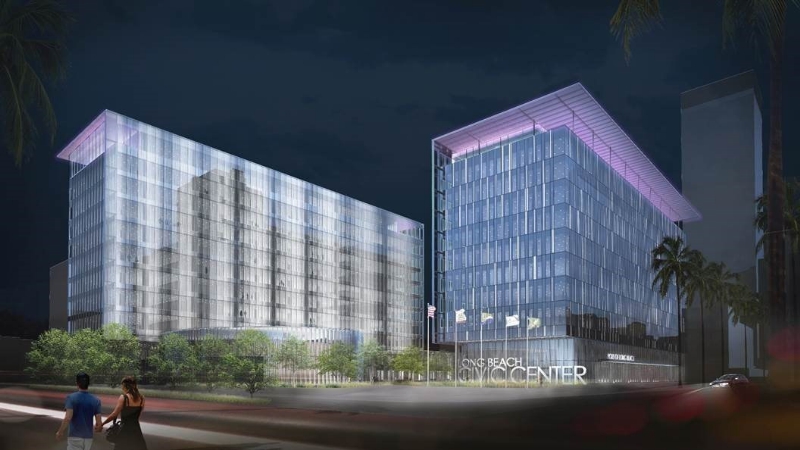Arup announced that the City of Long Beach and Port of Long Beach have reached financial close for the $520 million Long Beach Civic Center Project.
The project includes a new city hall, port HQ, main library, public park, and street improvements. All the features are designed to be occupied within a week of a major earthquake and meet REDi Gold earthquake performance, an operational resilience rating system developed by Arup.
A public-private partnership (P3) was used to fund the project, which combines public infrastructure and private mixed-use real estate development into one design-build-finance-operate-maintain arrangement.
Arup, the global interdisciplinary consulting and design services firm, served as lead advisor to the city and Port of Long Beach. The firm led financial, commercial, real estate, design, engineering, and cost consulting advisory services.
 Long Beach, Calif. Photo: Zen Skillicorn/Creative Commons.
Long Beach, Calif. Photo: Zen Skillicorn/Creative Commons.
The Arup team included HOK for architecture consulting, BAE for real estate economics, and MBI Media for outreach. Sheppard Mullin provided legal advice to the owners.
Plenary Group is the lead P3 developer, sole equity provider, and financial arranger for the consortium, which includes Clark Construction, Edgemoor, Johnson Controls, and SOM.
Allianz, in a private placement, is providing $237 million in long-term financing. Sumitomo Mitsui Banking Corp. is providing a $213 million loan. Long Beach would contribute $11.8 million in cash and land valued at nearly $30 million. Plenary is contributing $21 million in equity.
Arup managed the entire process from the RFP to the end of negotiations and helped the project become a reality quicker than expected.
"A significant value added for the city is how the P3 model accelerated what would more conventionally have been a three- to five-year project development process using traditional project delivery methods to a two-year process," Orion Fulton, Arup's project team leader, said.
Arup has served as an advisor for numerous projects, including Presidio Parkway in San Francisco, the Los Angeles Convention Center, and the New Champlain Bridge in Quebec.
Construction has begun, and the next phase of the project is being launched.
Related Stories
| Jun 2, 2014
Parking structures group launches LEED-type program for parking garages
The Green Parking Council, an affiliate of the International Parking Institute, has launched the Green Garage Certification program, the parking industry equivalent of LEED certification.
| May 29, 2014
7 cost-effective ways to make U.S. infrastructure more resilient
Moving critical elements to higher ground and designing for longer lifespans are just some of the ways cities and governments can make infrastructure more resilient to natural disasters and climate change, writes Richard Cavallaro, President of Skanska USA Civil.
| May 27, 2014
America's oldest federal public housing development gets a facelift
First opened in 1940, South Boston's Old Colony housing project had become a symbol of poor housing conditions. Now the revamped neighborhood serves as a national model for sustainable, affordable multifamily design.
| May 23, 2014
Top interior design trends: Gensler, HOK, FXFOWLE, Mancini Duffy weigh in
Tech-friendly furniture, “live walls,” sit-stand desks, and circadian lighting are among the emerging trends identified by leading interior designers.
| May 22, 2014
7 ways it pays to use BIM for data centers
Here’s where AEC firms and owners are getting the most bang for the buck when using BIM/VDC to coordinate data center projects.
| May 22, 2014
Big Data meets data centers – What the coming DCIM boom means to owners and Building Teams
The demand for sophisticated facility monitoring solutions has spurred a new market segment—data center infrastructure management (DCIM)—that is likely to impact the way data center projects are planned, designed, built, and operated.
| May 20, 2014
Kinetic Architecture: New book explores innovations in active façades
The book, co-authored by Arup's Russell Fortmeyer, illustrates the various ways architects, consultants, and engineers approach energy and comfort by manipulating air, water, and light through the layers of passive and active building envelope systems.
| May 20, 2014
Gensler envisions 'law firm of the future' with pop-up office project
Called "The Legal Office of the Future," the pop-up demonstration project made its debut this week at the annual conference for the Association of Legal Administrators in Toronto.
| May 19, 2014
What can architects learn from nature’s 3.8 billion years of experience?
In a new report, HOK and Biomimicry 3.8 partnered to study how lessons from the temperate broadleaf forest biome, which houses many of the world’s largest population centers, can inform the design of the built environment.
| May 13, 2014
19 industry groups team to promote resilient planning and building materials
The industry associations, with more than 700,000 members generating almost $1 trillion in GDP, have issued a joint statement on resilience, pushing design and building solutions for disaster mitigation.
















